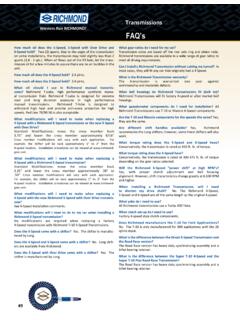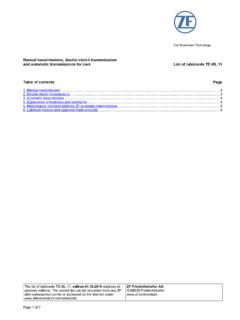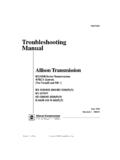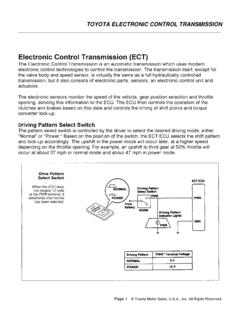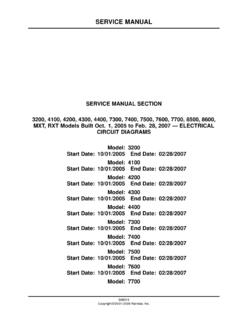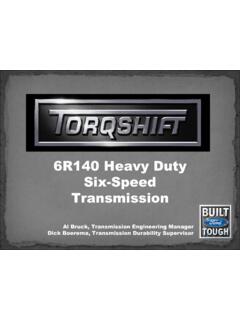Transcription of Hi-Performance Transmissions SUPER T10
1 Chicago, IL USATech Line: 864-843-9275 Fax: 864-843-1276 Email: S MANUALHi-Performance TransmissionsSUPER T10 TMTM1 Proudly assembled and individually tested in the USA. Manufactured using top grade materials, statistically controlled CNC machinery, state-of-the-art heat T10 Features and General Specifications 2 SERVICE PROCEDURESB ellhousing Alignment 3-4 Lubricants and Sealants 6 Installation 3-5 General 6 Disassemble 6-7 Clean and Inspect
2 7 Assemble 7-8 Torque Values and Specifications 9 Exploded View 11 Replacement Parts 12 Tooth Counts by Gear Number 13-14 Troubleshooting 15 Speedometer Information 16 Notes 10, 17-18 Chicago, IL USATech Line: 864-843-9275 Fax: 864-843-1276 Email: Born in the Muscle Car Era of the 1960 s, the Richmond SUPER T10 has been redesigned and improved for the 21st century.
3 NASCAR proven, the current SUPER T10 is 10 pounds lighter and 50% more durable than the original. The SUPER T10 is deigned to provide improved acceleration potential while best utilizing the advantages of a four speed transmission. A four speed ccountershaft helical gear transmission, the SUPER T10 is synchronized in all forward gears. First and reverse are constant mesh to prevent gear clash , while strut-type syn-chronizers provide longer life and easier shifting. Four models are available to fit specific applications. All four ratio sets provide a low first gear while retaining a relatively close spacing between 2nd to 3rd and 3rd to 4th shifts. The Richmond SUPER T10 should be your choice gor performance type automobiles, light trucks and selected models of intermediate and full-sized cars. Our engineering expertise and a PRO-QUALITY approach to drivers demanding winning performance are built into every transmis-sion that wears the Richmond T10 PlusPart # SUPER T10 Part # SUPER T103 INSTALLATIONAs with any high performance product, proper installation and set-up is critical for optimum performance.
4 The follow-ing are a few helpful hints to help you get the maximum performance from your new Richmond Transmission.** Shifter Set-Up Mount and adjust the shifter linkage before you install the transmission. Make sure that all rods are mount-ed and working freely without binding at the shifter hang-ers or the transmission itself. (Be sure rod adjustment is made with the rail alignment pin in place.) Once rods are set, set the shifter stops to prevent overshift.** Lubrication Many technological improvements in gear lubri-cants are available in the market today. It is hard to recom-mend one particular product for all applications. Thus far in our testing we found that a standard 85-90 wt. Petroleum oil will suit most applications. Synthetic gear lube, however, may be used to improve shiftability or cold weather start-up. This transmission is a significant investment, and you certainly don t want to ruin your transmission with a cheap lube.
5 We recommend Richmond GL6 synthetic manual transmission fluid.** The Clutch The clutch can truly be THE difference in the smoothness and shiftability of any transmission. In general, the more mass in the clutch, the more difficult shifting be-comes. And, of course, shifting at high rpm makes proper of clutch adjustment essential. In our testing thus far we have found a good starting point is .070 clearance.** Bellhousing Alignment Proper alignment of bellhousing to the motor is critical! The most common problems associated with a misaligned bellhousing are: jumping out of gear, vibration, excessive pilot bushing wear, difficult shifting, or excessive wear of the tailhousing and high performance drive train components have manufacturing tolerances which can shift the bellhousing into an unacceptable the engine block viewpoint, all machining for the main bearings is done at a right angle to the surface where the bellhousing bolts to the block.
6 Anytime an engine is lined-honed or bored, it could move the crankshaft centerline to the dowel pins at the rear of the a new bellhousing or a rebuilt motor is involved, we strongly recommend indicating the bellhousing to as-sure proper article specific to proper bellhousing alignment is includ-ed for your understanding of the importance of this matter. See following article for further ALIGNMENTB ellhousing alignment is absolutely essential to smooth and reliable clutch and transmission operation. Of major im-portance is the position of the bellhousing on the rear of the engine; the centerline of the transmission input shaft must line up exactly with the centerline of the crankshaft. In addition, the transmission mounting surface (rear of the bellhousing) must be parallel to the clutch engagement sur-face of the too frequently, the bellhousing or scattershield, is mere-ly bolted up by using the factory installed dowel pins as a guide.
7 But the placement of the dowel pins and the po-sitioning of the dowel pin holes in the bellhousing can be affected by the manufacturing tolerances of mass-produc-tion. Frequently, these tolerances multiply to produce a considerable alignment variety of problems can result from the bellhousing being out of alignment: pilot bearing failure, transmission bearing failures, clutch chatter, sloppy shifts, sluggish clutch move-ment, rapid synchronizer wear, or popping out of gear. And of course, the transmission and/or clutch takes the blame for what is really a bellhousing alignment dial indicator (with a magnetic base) is needed to veri-fy bellhousing alignment. Using stock dowel pins, install the bellhousing and tighten securely. The trueness of the flywheel should be the first checkpoint, because all sub-sequent alignment checks will use the flywheel face as a measuring point. The flywheel face must be perpendicu-lar to the centerline of the crankshaft if consistent, smooth clutch action is to occur.
8 This can be determined by mount-ing the dial indicator on the bellhousing. Rotate the crank-shaft slowly recording any variations on the dial indicator, by measuring from the flywheel to the bellhousing face (a runout of .005 is acceptable). If the flywheel runout is more than .005 , check for dirt or burrs on the faces of the flywheel or crankshaft. If there are none, flywheel warpage may be the problem and the flywheel may be in need of , affix the dial indicator to the flywheel (prior to clutch installation) and attached the indicator so that it contacts the bellhousing s transmission mating surface about one inch outside the rear opening. (Be sure to avoid the trans-mission mounting bolt holes and clutch pivot ball hole.) Ro-tate the crankshaft by hand slowly and note any variations INSTALLATION4in the indicator reading to determine if the surface is par-allel with the flywheel.
9 Maximum variation between the highest and lowest readings is .005 . If a greater variation is found, place shim stock in like with the low point be-tween the bellhousing and the block. Adjust shim thick-ness until variation of .005 or less are obtained. Again, carefully check the mating surfaces for dirt and burrs to make sure these are not causing the the dial indicator so that it measures the inside diameter of the rear opening in the bellhousing. Once again, be sure there is no paint buildup, nicks or burrs on the edges of the opening. Slowly, rotate the crankshaft and check the dial indicator readings. The maximum vari-ation is because the actual error is the total variation divided by two, or .005 misalignment. If the variation ex-ceeds .010 realignment is required. Make several revolu-tions of the crankshaft to verify the the bellhousing must be realigned, one of several ap-proaches can be used, in any case, the stock dowel pins must be removed from the block and discarded.
10 The stock pins must be removed carefully to avoid distorting or oth-erwise damaging the pin first method consists of simply loosening the bellhous-ing bolts to permit repositioning of the bellhousing until dial indicator reading variation of .010 or less is obtained. It may be necessary to enlarge the bellhousing bolt holes slightly to obtain sufficient movement. Then tighten the bolts and recheck it to ensure the housing hasn t shifted. With the bolts securely tightened and the housing proper-ly aligned, choose two points, approximately 180 degrees apart. It will be necessary to drill through the bellhousing flange and into the block for installation of the new dow-el pins. The new pins need not be as large as the stock ones. A diameter of 1/4 - 5/16 is sufficient. Once the new pins are in place, the bellhousing can be removed and reinstalled without the need to check second method utilizes offset dowel pins.


